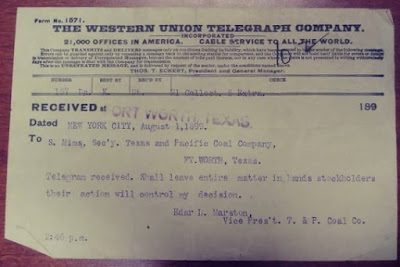Mining Tools: Implements or Heirlooms?

By Matt Stephenson
Coal mining is one of the most dangerous occupations in the world. In Thurber miners worked in coal seams that were often two to twenty feet thick. They spent the day hunched over or lying on their sides using hand tools and explosives to break coal deposits from a vertical rock face. The miner’s tools were crucial to his livelihood. They enabled him to do his job effectively and to feed his family.

The image of a coal miner would not be complete without a carbide lamp attached to his hat or helmet to light the way in darkness of a coal mine. Carbide lamps, properly known as acetylene gas lamps, produce and burn acetylene gas, which is the result of calcium carbide reacting with water. In addition to their use in mines, people employed them as building lighting, lighthouse beacons, headlights on motor-cars and bicycles, and today they are still the preferred method of personal illumination for cavers and spelunkers.

Coal miners used specialized picks weighing approximately 1-2 pounds to remove coal deposits from the rock facings underground. They were drop-forged from iron, had sharp points on each end and were mounted on a 12-18 inch wooden handle, depending upon preference. The company required a miner to remove 4.5- 6 inch chunks of coal. He was not paid for nut or pea-sized pieces. Because miners used their picks throughout their career, surviving examples show evidence of extremely heavy use.

Miners used blasting powder and a hand drill when coal deposits were too solid to mine with tools. Miners drilled tap-holes through the coal deposits to the surface of the rock facing, placed small explosive charges between the rock facing and the coal, and finally ignited the charge with a detonator or a simple fuse. As with hand-chipping, blasting required special skill and precision. As coal mining operations expanded, blasting powder eventually replaced picks.

In 1900 a skilled miner, such as Tom Krajcar was capable of mining approximately one ton of coal per man per day. For this he earned a wage of approximately $1.57 per day, or $52.00 per month on average. Miners in Thurber purchased their own picks and carbide lamps from the Texas and Pacific Manufacturing and Mercantile (TPM&M) company store. The combined price of tools would cost a miner $1.60-$2.00, which was more than he earned per day. Miners bequeathed their tools to the next generation in order to spare the descendant the expense of purchasing tools. The tools pictured here were owned and used by Thurber miners. The fact that their late owners’ families saved them attests to the strong memories evoked by tools and other similar items.





